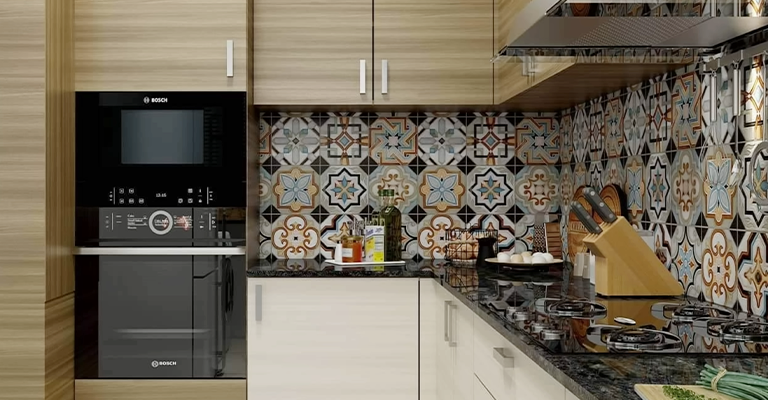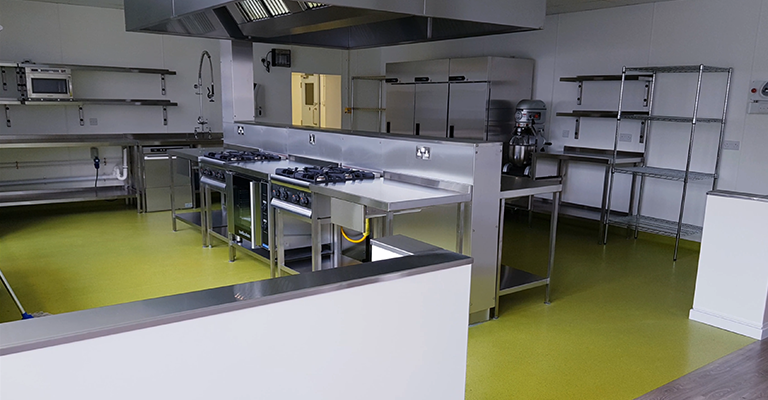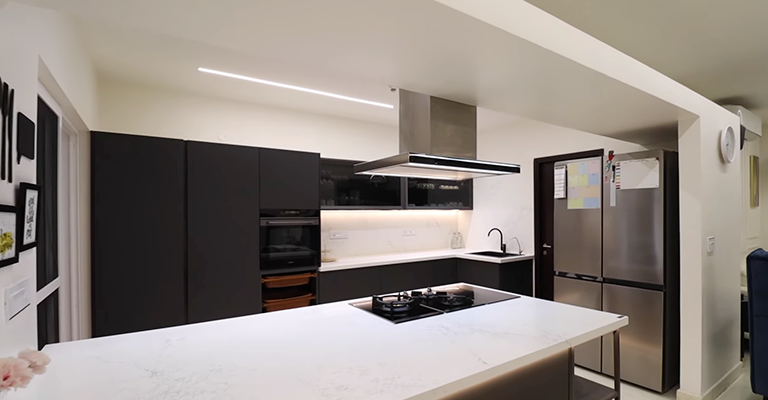What Is A Splashback Kitchen?
A kitchen’s functionality and aesthetic appeal hinge on a critical element – the splashback.
This integral feature, often situated behind the stove or sink, serves as a stalwart guardian, shielding walls from the onslaught of culinary activities. But it’s more than just a utilitarian barrier.
A splashback is a canvas for creativity, offering a diverse array of materials, colors, and patterns to infuse personality into the kitchen. Whether it’s sleek glass, timeless tiles, or natural stone, the choice of splashback profoundly influences the overall design.
In this exploration, we delve into the intricacies of what constitutes a splashback and its pivotal role in modern kitchen architecture.
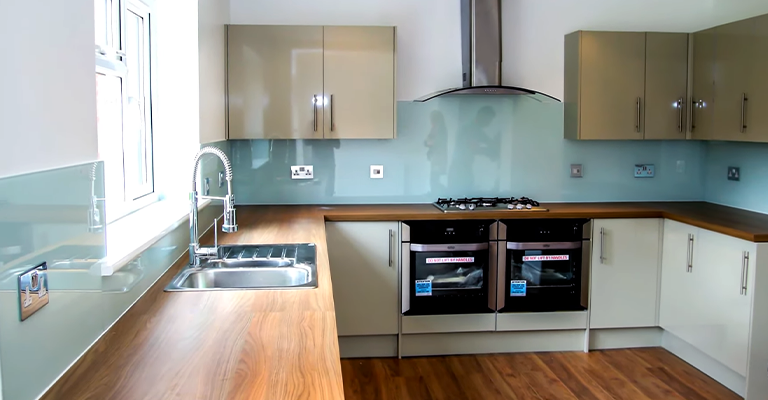
What Is A Splashback Kitchen?
A splashback, in the context of a kitchen, is an essential element of both functional and aesthetic significance. It is a protective surface that is typically installed on the wall behind the stove, sink, or countertops.
Splashbacks serve a dual purpose, providing a barrier against water, grease, and food splatters, while also enhancing the overall look and style of the kitchen.
Here are some key aspects to consider when discussing splashbacks in the kitchen:
Material Choices
Kitchen splashbacks are available in a wide array of materials, each offering distinct advantages.
Here are a few common options:
- Tiles
- Glass
- Stainless Steel
- Acrylic
- Natural Stone
Functionality
The primary function of a kitchen splashback is to protect the walls from damage. Near the stove, it shields against hot oil splatters, while near the sink, it prevents water damage.
The right material choice ensures that it can withstand these challenges. Regular maintenance, such as wiping down the splashback after cooking, is essential to prevent the buildup of grime and stains.
Design and Aesthetics
The design aspect of splashbacks is crucial for many homeowners. They offer an opportunity to infuse personality and style into the kitchen.
Popular design choices include subway tiles for a classic look, mosaic patterns for a touch of artistry, or solid colors to create a sleek and minimalist appearance.
Coordinating the splashback with the overall kitchen theme can tie the room together and create a harmonious atmosphere.
Ease of Cleaning
Ease of cleaning is a key advantage of many splashback materials. For example, glass and tiles are resistant to staining and can be wiped down effortlessly, making post-cooking cleanup a breeze. This practicality is especially valuable in busy kitchens.
Installation
While some may opt for DIY installation, it’s generally advisable to have a professional handle the job, especially for more complex materials like glass or natural stone.
A proper installation ensures that the splashback is secure, sealed correctly, and fits precisely in your kitchen space.
Cost
The cost of a kitchen splashback varies widely. Tiles are usually among the more budget-friendly options, while materials like natural stone and custom glass can significantly increase the budget.
It’s essential to consider your budget and weigh the benefits of the chosen material against its cost.
Maintenance
To maintain the appearance and longevity of your splashback, it’s important to use gentle, non-abrasive cleaners.
Harsh chemicals can damage the surface over time. Regular cleaning is advisable, especially for splashbacks positioned near the stove.
Complementary Design
Ensuring that the splashback complements the overall kitchen design is crucial. This includes considering the color, pattern, and texture of the splashback in relation to your cabinetry, countertops, and flooring.
The aim is to create a harmonious and aesthetically pleasing kitchen space where the splashback plays a significant role in tying the design elements together.
Functional Aspects of a Splashback
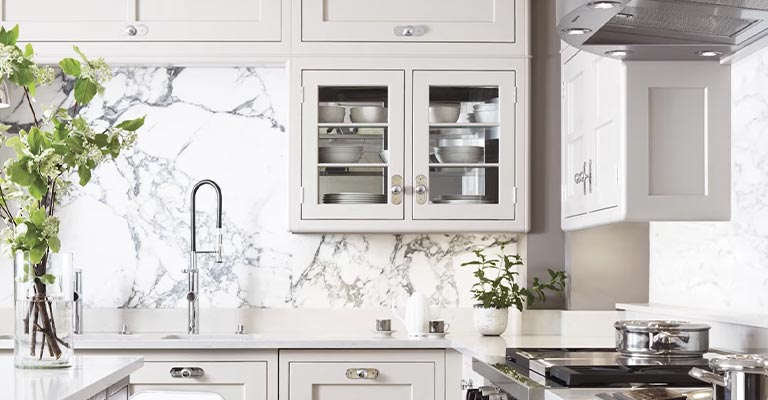
The functional aspects of a splashback in a kitchen are critical for maintaining cleanliness, preventing damage, and ensuring the longevity of both the wall and the surrounding surfaces.
Here are the key functional aspects of a kitchen splashback:
Protection from Splatters and Stains
The primary function of a splashback is to protect the walls from various kitchen mishaps.
Whether you’re frying food on the stove, washing dishes in the sink, or preparing meals on the countertop, splashbacks act as a barrier against splatters of water, cooking oils, sauces, and food particles.
Without a splashback, these substances can easily stain or damage the walls, requiring frequent repainting and repairs.
Hygiene and Easy Cleaning
Splashbacks are designed to be easy to clean, which is essential in a kitchen where cleanliness is a top priority.
Their smooth and often non-porous surfaces, like glass or tiles, make it easy to wipe off spills and splatters. The ensures a more hygienic kitchen environment and reduces the effort and time needed for cleaning.
Preventing Water Damage
Near the sink, splashbacks serve the critical function of preventing water damage to the wall.
They keep moisture from penetrating the wall’s surface, which can lead to structural issues, mold growth, and the deterioration of paint or wallpaper.
Heat Resistance
For splashbacks located behind the stove or cooktop, heat resistance is essential.
Materials like glass and stainless steel are excellent choices because they can withstand the high temperatures generated during cooking without warping, discoloration, or other damage.
Durability and Longevity
A well-chosen splashback material should be durable and long-lasting, ensuring that it can withstand the daily rigors of kitchen activities. Durability is crucial to avoid the need for frequent replacements or repairs.
Maintenance and Prevention of Grime Buildup
A properly installed splashback should have sealed edges and joints, which prevent food particles and moisture from getting behind the splashback. This reduces the likelihood of grime buildup and makes maintenance more straightforward.
Preserving the Wall’s Structural Integrity
Beyond aesthetics, splashbacks help preserve the structural integrity of the wall.
By preventing water seepage and stains, they extend the life of the wall and reduce the need for costly repairs or replacements.
Customization for Functionality
Depending on your kitchen’s layout and specific needs, you can customize the height and width of the splashback.
For example, some homeowners choose to extend the splashback all the way to the ceiling, providing additional protection and a unique design element. Others may opt for a partial splashback near the prep area.
Integration with Countertops and Cabinets
Integrating a kitchen splashback with your countertops and cabinets is crucial for creating a cohesive and visually appealing kitchen design.
Here are some considerations for achieving a harmonious look:
Color Coordination
Ensure that the colors of the splashback, countertops, and cabinets work harmoniously together.
They don’t necessarily need to match perfectly, but there should be a cohesive color scheme that ties the elements together.
Contrasting Elements
Consider using contrasting colors or materials to create visual interest. For instance, if you have dark cabinets, a light-colored or patterned splashback can provide a striking contrast.
Material Consistency
If possible, use similar or complementary materials for the splashback, countertops, and cabinet surfaces.
This creates a cohesive and unified look. For example, if you have marble countertops, consider a marble-look splashback.
Continuity in Design
Extend the design elements across the kitchen space. For example, if you have a subway tile splashback, consider using the same tiles for a coordinated backsplash behind the sink or as a feature wall.
Edge Treatments
Pay attention to the edge treatments of countertops and the upper edge of the splashback.
They should complement each other in terms of finish and style. For instance, a sleek, modern countertop edge may pair well with a similarly finished splashback.
Height Consideration
Determine how high you want the splashback to go. It can cover only the area behind the stove and sink, or extend to cover a larger section of the wall. Coordinating the height with the countertops and cabinets creates a balanced look.
Backsplash Selection
The backsplash is an extension of the splash with chosen with the countertop and cabinet materials.
It often serves as a transitional element, visually connecting these two key areas of the kitchen.
Hardware and Fixtures
Ensure that hardware and fixtures, such as faucet finishes, cabinet pulls, and knobs, complement the overall design. This contributes to a unified look and avoids any clashing or discordant elements.
Maintaining Visual Flow
Create a sense of visual flow by using similar or complementary colors and patterns.
This can be achieved by selecting materials and colors that guide the eye smoothly from the countertops up to the splashback and cabinets.
Consider Focal Points
Determine if you want the countertops, splashback, or cabinets to be the focal point of the kitchen.
You can use design elements like contrasting colors or unique patterns to draw attention to one of these areas.
Contemporary Styles and Patterns
In contemporary kitchen design, styles and patterns play a significant role in creating a modern, up-to-date look.
Here are some popular contemporary styles and patterns that can be incorporated into your kitchen:
Minimalist Design
Minimalism is a hallmark of contemporary design. It emphasizes clean lines, uncluttered spaces, and a “less is more” approach.
In a contemporary kitchen, this can be achieved by using sleek, flat-front cabinets, minimal hardware, and a simple, unadorned splashback in a solid color.
Geometric Patterns
Geometric patterns, such as hexagons, chevrons, or herringbone, are often used for contemporary splashbacks. These patterns add visual interest and a sense of modernity to the kitchen.
Monochromatic Color Schemes
A monochromatic color scheme, with various shades of a single color, is a common choice for contemporary kitchens.
For the splashback, this can mean using varying tones of a single color, creating a sophisticated and cohesive look.
High-Gloss Finishes
High-gloss materials like glossy tiles or lacquered cabinets can reflect light and add a sense of luxury to the kitchen. They are a popular choice in contemporary design for their sleek appearance.
Industrial Influence
Industrial-inspired design elements, such as exposed brick, concrete, or metal accents, can be incorporated into contemporary kitchens.
A concrete-look splashback or metal tiles can give the kitchen an urban, industrial edge.
Subway Tiles
While subway tiles are a classic choice, they have a timeless appeal that works well in contemporary kitchens.
They can be arranged in various patterns, such as a vertical stack or a herringbone layout, to add a modern twist.
Texture Play
Contemporary kitchens often incorporate various textures. Textured splashback materials, like 3D tiles, can introduce depth and tactile interest into the design.
Color Blocking
Color blocking involves using bold, contrasting colors in a deliberate and eye-catching manner.
This can be applied to the splashback with two or more solid colors that create a striking visual statement.
Open Shelving
Open shelving, featuring clean lines and a lack of ornamentation, is a contemporary trend.
This style can be incorporated into the design to showcase dishes, cookware, and decorative items.
Digital and Custom Prints
Contemporary technology allows for custom-printed splashbacks with digital images, patterns, or artwork. This unique, personalized touch can serve as a focal point in the kitchen.
Splashback Kitchen Maintenance and Cleaning Tips

Maintaining and cleaning your kitchen splashback is essential to preserve its beauty and functionality.
Here are some tips to keep it looking its best:
Regular Wipe Down
After cooking, make it a habit to wipe down the splashback with a damp cloth or sponge.
This helps prevent food and grease from sticking to the surface and makes deeper cleaning sessions less demanding.
Use Mild Detergents
When you need a more thorough cleaning, use a mild dish soap or a mixture of warm water and vinegar. Avoid harsh, abrasive, or chemical-based cleaners that can damage the surface.
Avoid Abrasive Scrubbers
Don’t use abrasive scrubbers, steel wool, or harsh scouring pads on your splashback, as they can scratch and damage the surface. Stick to soft sponges or clothes.
Clean Stains Promptly
Deal with stains as soon as they occur. Common kitchen splatters like tomato sauce or oil can leave stubborn marks if left unattended. Wipe them away as soon as possible.
Rinse and Dry
After cleaning, rinse the splashback with clean water to remove any soap residue. Dry it with a clean, dry cloth to prevent water spots or streaks.
Consider Your Material
The cleaning method depends on the material of your splashback. For glass or acrylic, a simple glass cleaner might suffice.
For tiles, pay attention to the grout as well. Use a grout brush and a mild grout cleaner to keep it clean.
Prevent Grease Buildup
When your splashback is located near the stove, it’s essential to prevent grease buildup.
Consider installing a range hood or regularly clean the filters in your existing one to minimize grease particles in the air.
Seal Natural Stone
When you have a natural stone splashback, such as marble or granite, it’s essential to seal it regularly to protect it from staining. Consult the manufacturer’s recommendations for sealing frequency.
Use a Splashback Guard
Consider using a transparent, heat-resistant splashback guard behind the stove to protect your main splashback from extreme heat and grease splatters.
Inspect Caulking
When your splashback includes caulking at the edges or seams, periodically inspect it for any signs of wear or damage. Replace it if necessary to maintain a watertight seal.
Maintain Grout Lines
When you have tiled splashbacks, inspect and maintain the grout lines. If grout begins to crumble or discolor, remove and replace it to ensure a clean and uniform appearance.
Avoid Harsh Chemicals
Harsh chemicals like bleach, ammonia, or abrasive cleaners can damage your splashback. Stick to gentle, pH-neutral cleaning solutions to protect the surface.
Be Gentle with Glass
Glass splashbacks can scratch or crack if mistreated. Use a soft cloth or microfiber towel to clean and polish the glass surface.
Prevent Excessive Moisture
Ensure that there are no gaps or loose seams in the splashback that could allow moisture to seep behind it.
Proper installation and maintenance are crucial to prevent water damage to the wall.
FAQs
What is the purpose of a splashback in the kitchen?
A kitchen splashback serves the dual purpose of protecting the wall from food splatters and water damage while also enhancing the kitchen’s aesthetics.
Can I install a splashback in any kitchen?
Yes, splashbacks are versatile and can be installed in most kitchens.
How do I clean and maintain a glass splashback?
Glass splashbacks can be cleaned with a glass cleaner or a mixture of warm water and mild dish soap.
Are there eco-friendly options for splashbacks?
Yes, there are eco-friendly choices for splashback materials, such as recycled glass or sustainable materials like bamboo.
Can I install a splashback myself, or do I need a professional?
While some homeowners with DIY skills can install splashbacks, it’s often recommended to hire professional materials, to ensure a precise fit and proper sealing.
To Recap
A kitchen splashback is a multifaceted element that seamlessly blends function and style. It acts as a protective barrier, shielding walls from splatters and stains, particularly around high-activity areas like the stove and sink.
Simultaneously, it’s a canvas for design expression, offering a wide array of materials, patterns, and colors. The choice of a splashback profoundly influences a kitchen’s aesthetic, contributing to its overall charm and character.
Whether opting for minimalist elegance, bold patterns, or timeless classics, a well-chosen splashback enhances both the practicality and visual appeal of the kitchen.
It stands as an essential component in creating a harmonious and inviting culinary space.
